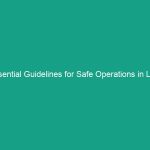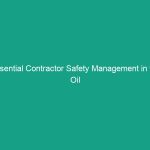Good morning team!
Today, we are going to discuss an essential topic that affects all of us on the job: Essential Spotter Safety Guidelines: Avoid Critical Risks on the Job. Understanding and applying these guidelines is crucial for ensuring not only your Safety but also the Safety of your coworkers. Spotters play a vital role in many operations, especially in construction, logistics, and heavy machinery handling. By following the right safety practices, we can significantly reduce the risks involved in our daily tasks.
Understanding Essential Spotter Safety Guidelines
Spotters serve as the eyes and ears for operators of heavy machinery, providing essential guidance to prevent accidents and ensure smooth operations. The importance of these guidelines cannot be overstated. When spotters are properly trained and follow safety protocols, the likelihood of workplace accidents decreases dramatically.
One common misconception about spotters is that their role is secondary or less significant than that of the equipment operator. In reality, the spotter’s role is equally critical in maintaining a safe working Environment. When spotters are vigilant and adhere to safety guidelines, they help to prevent collisions and accidents involving personnel and equipment.
Key Hazards, Risks, and Safety Considerations
In our line of work, several Hazards can arise if spotters and operators do not communicate effectively or follow safety protocols. Some of these hazards include:
- Blind Spots: Heavy machinery often has blind spots that can obscure the operator’s view of personnel or obstacles.
- Communication Barriers: Miscommunication between the spotter and the operator can lead to accidents.
- Environmental Factors: Weather conditions, uneven terrain, and nearby pedestrian traffic can create additional risks.
- Improper Use of Signals: Inconsistent or unclear signaling can exacerbate risks.
Ignoring safety protocols can lead to severe injuries or even fatalities. For example, a construction site accident occurred because the spotter and operator did not have a clear communication plan in place, resulting in a collision with a worker. This incident highlights the importance of adhering to safety guidelines and ensuring that everyone understands their roles and responsibilities.
Best Practices, Procedures, & Actionable Advice
Now that we understand the risks, let’s discuss practical steps we can take to ensure safety:
1. Pre-Operation Safety Briefing
Before beginning any Operation, conduct a safety briefing. This should include:
- Identifying the spotter and operator.
- Discussing the specific tasks to be performed.
- Reviewing the communication signals that will be used.
2. Clear Communication
Establish a clear communication protocol. Use standardized hand signals or radios if necessary. Make sure everyone understands the signals and chooses a signal leader who will be responsible for maintaining clear communication throughout the operation.
3. Maintain Situational Awareness
Both spotters and operators should maintain situational awareness at all times. Spotters should continuously scan the work area for any potential hazards, while operators should remain focused on their equipment and the signals from their spotter.
4. Use of Personal Protective Equipment (PPE)
Ensure that all workers, including spotters, wear appropriate Personal Protective Equipment (PPE). This includes hard hats, high-visibility vests, gloves, and safety shoes. PPE is essential in reducing injury risk.
5. Training and Certification
All spotters should undergo proper Training and certification. Regular refresher courses can help reinforce safety guidelines and keep everyone informed about new Procedures or equipment.
6. Reporting Hazards
Encourage everyone to report any unsafe conditions or practices. An open-door policy for discussing safety issues can foster a culture of safety and prevent accidents before they occur.
Regulations, Standards, and Compliance
It’s essential to be aware of and comply with relevant safety Regulations and Standards. The Occupational Safety and Health Administration (OSHA) provides guidelines that must be followed to ensure Workplace Safety. Compliance with these standards is crucial, as it not only protects employees but also shields the company from potential legal issues and fines.
Some key regulations to be aware of include:
- osha Standard 1926.1428 – When operating cranes.
- OSHA Standard 1926.1404 – Regarding signal persons.
Understanding these standards and implementing them in our daily operations is essential for maintaining a safe work environment.
Employee Engagement & Discussion
Before we wrap up, I’d like to open the floor to some discussion. Here are a few questions to consider:
- What safety challenges have you encountered related to spotter operations?
- Can you share an instance where effective communication made a difference in a task?
- What additional training or resources do you think would enhance our safety practices?
Your insights and experiences are invaluable in creating a safer workplace for everyone.
Conclusion & Key Takeaways
In conclusion, adhering to essential spotter safety guidelines is critical for preventing accidents and ensuring the safety of everyone on the job. By understanding the key hazards, following Best Practices, and complying with safety regulations, we can create a safer work environment.
Remember, safety is everyone’s responsibility. It takes a collective effort to prioritize safety on the job. Thank you for your attention today, and let’s continue to work together to keep our workplace safe and secure.


